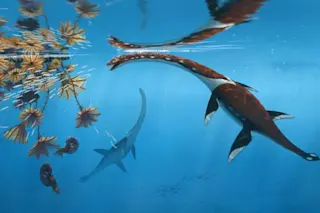Aquatic animals delivered a one-two predatory punch millions of years ago. A combination of different teeth marks on “sea cow” bones show that a crocodile snatched the creature’s skull and drowned it with a “death roll”— essentially rotating underwater while grasping the sea cow in its jaws. When the croc was done dining, sharks showed up to finish the leftovers.
The study, in the Journal of Vertebrate Paleontology, provides a rare example of a creature being attacked by two different predators during the Early to Middle Miocene epoch (23 million to 11.6 million years ago).
This example is significant because it draws a clear link to similar predatory behavior that still exists. And it is rare because an initial attack, followed by secondary scavenging, rarely leaves much evidence. “Examples of multiple predation, in general, are hard to find because most scavengers tear animals to shreds,” says Aldo Benites Palomino, the ...














